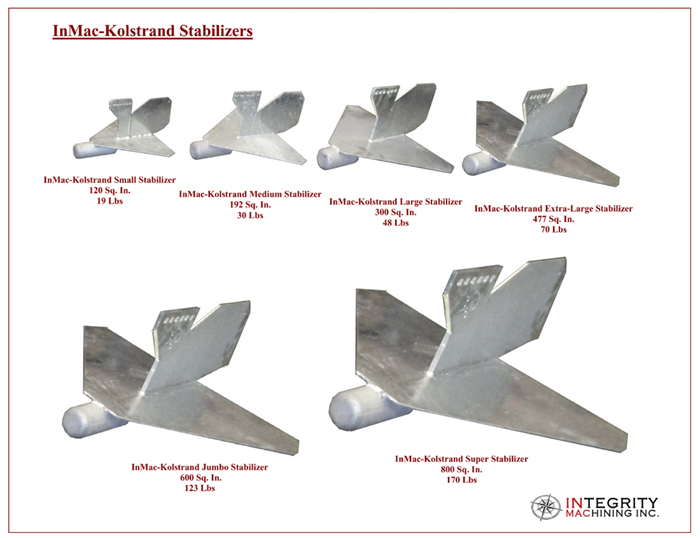Stabilizers

InMac-Kolstrand Stabilizers have long been known by fishermen as ‘fish’, 'flopper-stoppers' or ‘paravanes’… Whatever you call them, trust InMac-Kolstrand Stabilizers to lower your pitch and roll, making your ride more comfortable, while they fly thru the water!
The following information is taken from the United States Patent #2,561,539 in order to help explain the Kolstrand Stabilizer, the object of its use, and how it is used.
This invention relates to submersible marine stabilizers to be suspended from two outwardly and upwardly extended main poles on opposite sides of the vessel, so that the stabilizers will be submerged in the water alongside the boat. The stabilizers should be under the surface of the water 10 to 15 feet deep so they will not pull out of the water in rough weather or sea conditions.
When the stabilizers are connected with the main poles of the boat, they will operate in the following manner, to stabilize the boat and minimize the rolling of the said boat, in a rough sea. If the boat rolls to either side, obviously one stabilizer will move downward and the other stabilizer will move upwardly in the water. The main plate (wing) of the stabilizer being moved upwardly will be approximately horizontal in the water and will tend to retard or decrease the roll of the boat. The weight of the stabilizer which is moving downwardly in the water will orient the plate (wing) of this stabilizer into approximately a vertical position and this downwardly moving stabilizer will “dive’ or will move downwardly as fast as the slackening of its cable will permit. As soon as the boat starts to roll in the opposite direction, the action of the two stabilizers will be reversed, with the previously horizontal stabilizer plate assuming a vertical position and diving or moving downwardly in the water and the previously vertical stabilizer plate assuming a substantially horizontal position, so that it offers maximum resistance to the roll of the boat which tends to lift it upwardly through the water.
In a similar manner, the plate is very quickly angularly moved from a substantially horizontal position by the upward pull exerted on the cable. When said plate (wing) is moved from a vertical to a horizontal position by the upward lift of the cable, the leverage afforded by the stabilizer mast and upward pressure of the relatively wide rear end portion of the plate against the water helps to orient the plate quickly. Thus the retarding pull of the stabilizer will be exerted on the cable the instant upward movement of said cable begins. As the boat rolls toward a stabilizer and then reverses its direction of roll, the stabilizer first dives rapidly and then quickly resumes a horizontal position. This insures that there will not be any slack to take out of the cable when the boat reverses its direction of roll, and consequently there will not be any jerk or abrupt retarding force applied to the cable or poles or other rigging.
These stabilizers will operate efficiently to minimize the roll of a boat that is Anchored, or is moving at Trolling Speed, or at Cruising Speed. This makes it possible to operate a boat in rougher water than it can be operated in without the stabilizer, and in doing so often makes it possible to operate a boat more hours per day. Also the use of these stabilizers makes it safer and easier to work on the deck of the boat in rough weather.
